Highlights
- In our study, only a little more than half of all couples reported that they talk about pornography openly in their relationship. Post This
- Couples where neither partner consumes pornography have the highest levels of relationship stability, commitment, and relationship satisfaction. Post This
- 20% of dating and married men feel unable to stop their pornography use, and approximately 1 in 5 dating and married women are worried that their partner cannot stop watching pornography. Post This
It is no secret that pornography has become commonplace in our modern society. While sexually explicit material is not a new phenomenon, widespread access to the internet, the advent of “smart” technology, and the rise of social media have contributed to a modern culture that is saturated with pornographic content. Recent estimates suggest that nearly 80-90% of young adults report some exposure to pornography1 with the average age of first exposure often between 10-13 years old.2
Despite pornography viewing being an increasingly common behavior, we know very little about its potential impact on romantic couples. The large proportion of the teen and adult population who report using pornography all but guarantees that most romantic couples must navigate, either openly or privately, the role pornography plays in their relationships. It remains unclear how couples are navigating these trends—particularly since we know there are well-documented differences between men’s and women’s use of pornography.3
We recently released a report detailing our preliminary findings from a new survey entitled the National Couples and Pornography Study. This study was fielded in 2020 and was sponsored by the Wheatley Institution and the Austin Institute. Our study consists of two related samples that were recruited from across the United States based on quotas for age, race, education level, and geographic region aimed at creating a demographically diverse sample. The first sample consists of 3,750 individuals who are in committed heterosexual couple relationships. The second sample consists of 713 matched heterosexual couples (1,426 individuals).
In our study, we examined the impact of pornography use on couple relationships (see our summary here). We also looked at couple relationships patterns related to pornography use. In particular, we looked at what could be called the four “Cs” of couple pornography patterns—concealment, communication, concerns, and conflict.
Partner Awareness and Concealment
As we noted, large and consistent gaps continue to exist in the frequency and type of pornography viewed by men and women. One obvious issue with this gap in behavior is that it sets up a high probability that partners may hide behavior they think their partner may not accept or approve. We explored awareness of partners’ pornography use to see if romantic partners had a sense of the amount of pornography their partner was using.
Figure 1 shows how accurate these assessments were in the survey. We found that matched partners were surprisingly inaccurate in their reports of their partner’s porn use. While just under half of men reported accurate pornography use for their partner, the other half were inaccurate to some degree.
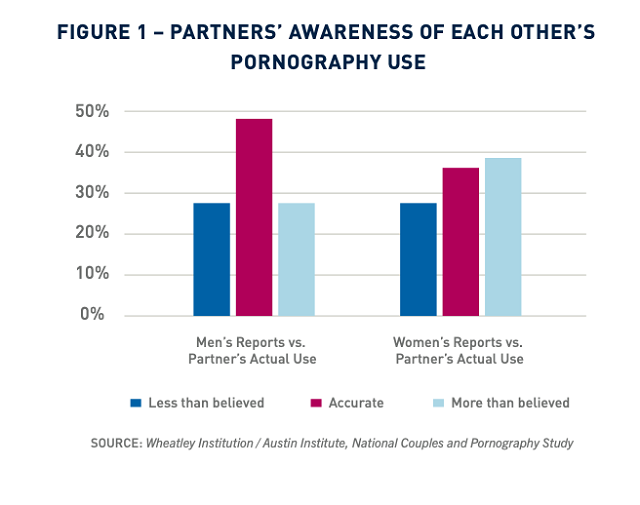
On the other hand, women were even less likely to accurately report their partner’s pornography use. Only about a third of women were accurate in their assessment of their partner’s pornography use. Women were much more likely to underestimate their partner’s pornography use (almost 40%) compared to overestimating it (about 25%).
Of course, many of the partners who were accurate regarding what their partners were viewing are likely couples where neither partner views pornography. Are couples where one or both partners regularly view pornography just as accurate in their perceptions of their partner’s use? We looked again at awareness levels of partner use, but this time, we explored the level of accuracy only when the other partner was regularly viewing pornography. We found that among those with a partner who reported viewing pornography, partners were generally much less accurate in their perceptions of their partner’s use. For both men and women, over half of all partners underestimated the pornography use of their partners. This finding suggests that when individuals are utilizing pornography alone, the majority of their romantic partners are either unaware of it use or not aware of the extent of such use.
We also assessed whether or not individuals are concealing their pornography use from their partner. As seen in Figure 2, about 1 in 4 men reported hiding or withholding their own pornography use from their partner. While not a majority, this number is significant, suggesting that roughly 25% of men report that they are actively hiding pornography use from their partner. About 10% of women report hiding their personal pornography use from their partner. Combined with the previous data, it would appear that a significant group exists, particularly of men, who either actively hide their use from their partner or passively avoid discussing the extent of their use with their partner.
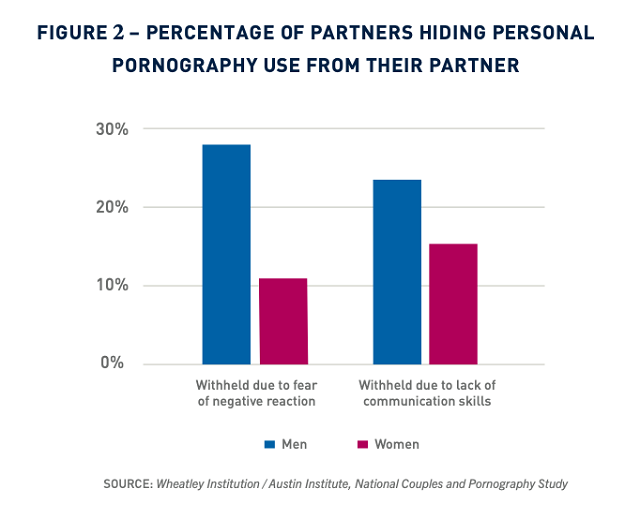
Communication About Pornography
With clear differences between men and women in both their acceptance and use of pornography, what is even less clear is how these differences affect couples—and how partners are negotiating and making sense of such differences in their relationship. As we just noted, it appears that many partners and spouses are unaware or misinformed about the pornography use of their partner. Does this suggest that couples are rarely talking about pornography openly? Such lack of communication may become a key factor in understanding any potential relationship quality differences that do emerge between couples based on their pornography viewing profiles.
In our study, only a little more than half of all couples reported that they talk about pornography openly in their relationship. Further, the majority had neither set rules for pornography use in the relationship, nor discussed limits and boundaries around pornography use in their relationship (see Figure 3). Clearly, the lack of open and clear communication about pornography appears to be a common issue for many modern couples.
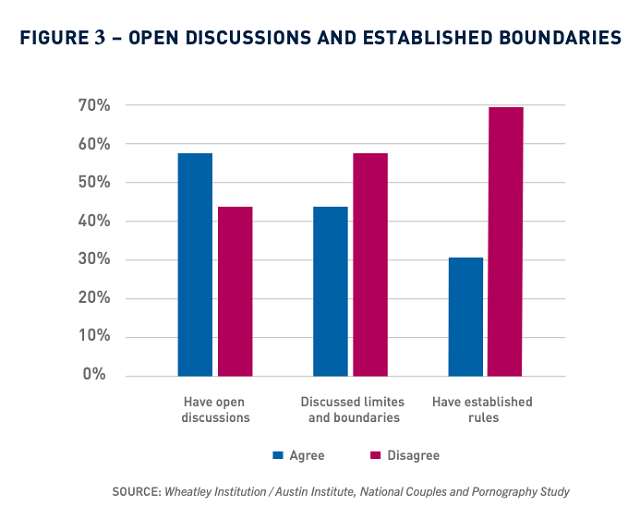
Concerns About Pornography
Further examination of the specific fears and anxieties romantic partners may have about pornography use within their relationship revealed several notable trends. Even though the majority of individuals reported a general acceptance of pornography use by adults, our analyses suggested that accepting something and attitudes about its potential effect in one’s own personal life are two different things. When asked specific questions about their anxieties and fears about pornography use, such fears appeared to be almost as common among romantic couples as was their general acceptance of pornography.
Many partners and spouses worry about how pornography may influence their sexual intimacy. Dating women appear to have the most worries, with almost 1 in 3 dating women reporting that they worry their partner is more attracted to pornography than to them. Also, about a third of dating women also reported worrying that their partner is thinking about pornography during sex.
It also appears that many women also worry about their male partners hiding their pornography use, a seemingly justified concern given the amount of concealment reported by male partners. Figure 4 shows that almost 1 in every 3 dating women reported they were worried that their partner was withholding some details about their pornography use. Married women and men were generally less anxious about concealment behaviors, but approximately 1 in 4 still reported some worry about this issue.
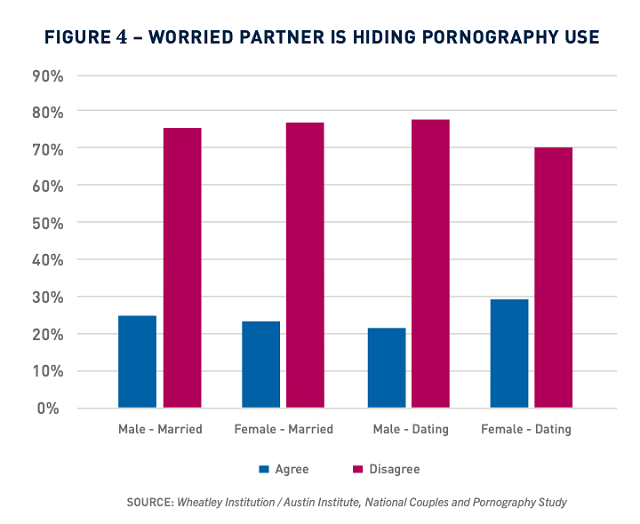
Another area of concern that we discovered in some couple relationships is worry expressed about self-control and whether or not individuals feel that they or their partner could stop watching pornography. In particular, we asked respondents how much they agreed with two statements. First, “I feel unable to stop my use of online pornography,” and “I am worried that my partner cannot stop watching pornography.”
Figure 5 shows that 20% of dating and married men agreed that they feel unable to stop their pornography use. Women were dramatically less, with only 4% of dating women and slightly less than 3% of married women reporting the same worry. However, some women did report that they are worried about their partner’s use, with approximately 1 in 5 dating and married women reporting they worry that their partner cannot stop watching pornography. This figure closely matches the number of men who worry about their own self-control related to pornography use.
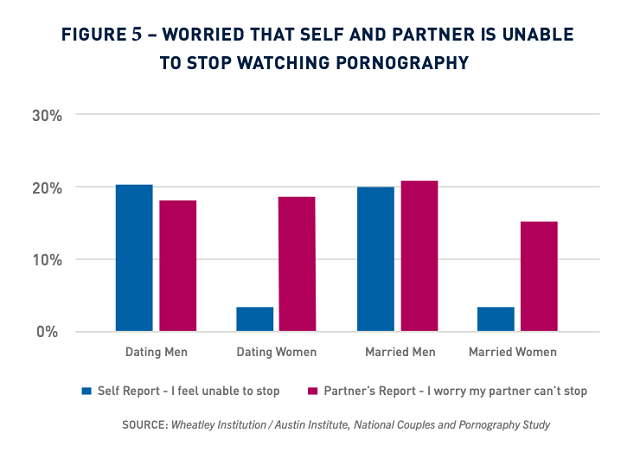
Conflict About Pornography
While a notable number of couples are reporting anxiety and concerns about pornography in their relationship, is pornography use causing open conflict between couples? When asked to report if pornography use has caused conflict in their relationship, we found that approximately 20% of couples reported that pornography had indeed been a source of conflict for their relationship.
Not surprisingly, conflict related to pornography use was much less common among couples where neither partner viewed pornography, with only about 1 in 10 of both men and women reporting that pornography has caused conflict in their relationship. However, when pornography was consumed by one or both partners, the opportunities for pornography to cause couple conflict rose steeply. The number of couples experiencing conflict doubled when one or both spouses reported using pornography.
Conclusion
Taken together, our data show a consistent and important theme related to pornography use in modern relationships between men and women. A consistent, notable portion of romantic partners, ranging between 20-40% depending on the specific metric, report concerns and anxieties about how pornography use is influencing their romantic relationship. Furthermore, these concerns are often occurring in a relationship setting where partners are hiding the specifics of their pornography use from their partner, and the majority of couples have not discussed limits and boundaries around pornography use.
Relationship experts have long recognized that relationship quality is a result of partners developing a secure attachment with each other, where each partner trusts that the other will be physically, emotionally, and psychologically responsive to his or her needs. Behaviors that are interpreted as disrupting or eroding this trust will have a significant negative impact on couple communication, intimacy, and satisfaction. Perhaps that is why our study also found that couples where both partners do not consume pornography have the highest levels of relationship stability, commitment, and relationship satisfaction.
Jason S. Carroll, Ph.D. is the Associate Director of the Wheatley Institution and a Professor in the School of Family Life at Brigham Young University. Brian J. Willoughby, Ph.D. is a Professor in the School of Family Life and a Fellow of the Wheatley Institution. Matthew T. Saxey is a Family Studies Master's Student at Brigham Young University and current Wheatley Institution Student Scholar and Misha D. Crawford is a Master’s student in the Marriage, Family, and Human Development program, Brigham Young University.
References
1. Davis, A. C., Carrotte, E. R., Hellard, M. E., Lim, M. S. (2018) What Behaviors Do Young Heterosexual Australians See in Pornography? A Cross-Sectional Study, The Journal of Sex Research, 55:3, 310-319.
2. Sinkovic, M., Stulhofer, A., & Bozic, J. (2013). Revisiting the Association between Pornography Use and Risky Sexual Behaviors: The Role of Early Exposure to Pornography and Sexual Sensation Seeking. Journal of Sex Research, 50, 633-641.
3. Carroll, J. S., Busby, D. M., Willoughby, B. J., & Brown, C. (2017). The Porn Gap: Differences in Men’s and Women’s Pornography Patterns in Couple Relationships. Journal of Couple and Relationship Therapy, 16 (2), 146-163.














